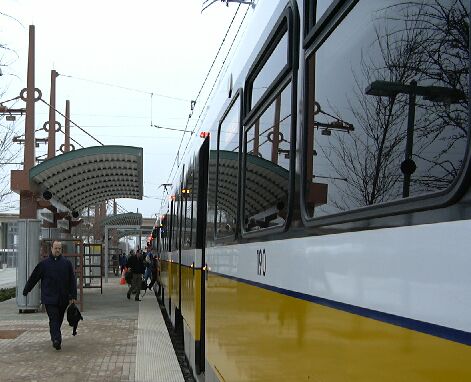
Light Rail Progress can be contacted at: Light Rail Progress |
Now expanded to 44 miles of line and 34 stations, Dallas's light rail transit (LRT) system today – operated by Dallas Area Rapid Transit (DART) – represents one of the largest rail expansion projects in North America, doubling the length of DART's original six-year-old, 20-mile light rail system. Most importantly, DART's LRT system continues to break ridership records. [Source: DART News Release: 25 November 2002; Dallas Morning News, 23 Feb. 2003] And, given the current debate over "Bus Rapid Transit" (BRT) vs. LRT, results from these latest DART expansions provide additional and illuminating new data which underscore the effectiveness of LRT in attracting new ridership. This is indicated by DART data providing before-and-after ridership figures for several new LRT stations corresponding to sites previously served by DART BRT-style express bus services. · Express Bus Route 200 formerly served the area of north Plano now served by LRT at the Parker Rd. station. · Express Bus Route 201 formerly served the area between Richardson and Plano now served by LRT at the Arapahoe Center station. · Express Bus Route 282, routed on the HOV lane on the I-30 freeway east of the Dallas CBD, formerly served central Garland, now served by LRT at the Downtown Garland station.
Early-morning passengers hurry to board LRT train at Bush Turnpike station. Express bus routes, including routes on the I-30 HOV lanes, were examined and included as examples of "BRT" in a 2001 report by the US General Accounting Office, "Mass Transit: Bus Rapid Transit Shows Promise" (GAO-01-984, Washington, Sept. 2001). Based on purported data from Dallas (the GAO Dallas data have actually been challenged by critics) and several other cities, the GAO concluded that "...Bus Rapid Transit shows promise in meeting a variety of transit needs." (Also see our article, GAO's "BRT" Report: Errors, Anomalies, Misinformation.) Regarding ridership, the GAO report claims that, while there was considerable variation, "the largest ridership on Bus Rapid Transit and Light Rail systems [was] quite similar." The report suggests that "BRT" tends to offer higher levels of service, with the implication that as many or higher levels of ridership are attracted to express-bus "BRT" as to LRT. These inferences appear to be refuted by the data from Dallas for the three new stations noted above. These data, provided by DART's Planning information and Analysis section in March 2003, are summarized in the table below, which shows weekday ridership for the previous express bus service and the new LRT service for each of the three stations.
From these data, it can be seen that LRT service has nearly tripled the total previous "BRT" ridership. These data results are represented visually in the graph below (adapted from a graph provided by DART).
For DART and Dallas area planners, the gains in ridership for the latest LRT extensions have been little short of astounding. For example, the number of daily LRT riders who used DART's Parker Road station in January was close to 2010 projections for weekday use. These and other spectacular results have led many planners to conclude that, while lower-cost "BRT" service on freeways and HOV lanes may help build transit ridership and provide a precursor service for bona fide rapid transit, it's no substitute for LRT. DART seems convinced that its investment in LRT is paying off in terms of providing high-quality public transit mobility for regional travellers and persuading motorists to park their cars and make the switch to transit – helping bring effective relief for the Dallas area's relentless growing mobility congestion. Updated 2003/09/26 |
||||||||||||